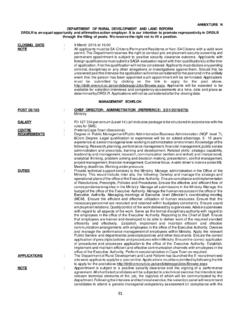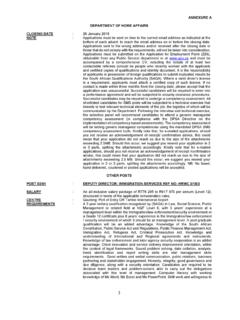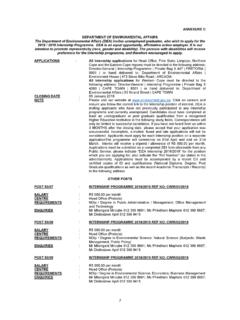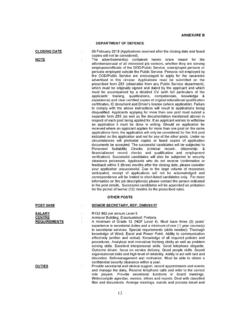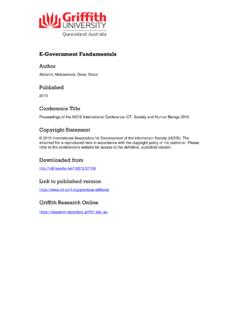Transcription of Public Service Corporate Governance of Information and ...
1 Public Service Corporate Governance of Information and Communication Technology Policy Framework December 2012. i EXECUTIVE SUMMARY. Government transformation is, at a strategic level, informed by government-wide key priority areas that have been translated into 12 strategic outcomes, guided by the Batho Pele principles of equal access to services, increased productivity and lowering of costs. The purpose of Information and communication technology (ICT) is to enable the Public Service in its quest for Service delivery. The ICT House of Value1. depicts the values and key focus areas of ICT Service delivery. These strategic outcomes, principles, values and key focus areas inform the acquisition, management and use of ICT. To determine whether ICT in the Public Service delivers an enabling Service , various investigations have been done to establish the shortcomings of ICT Service delivery. The first of these was the 1998 Presidential Review Commission (PRC) report, which stated that all-important ICT-decisions should come from the senior political and managerial leadership of the state and not be delegated to the technology specialists, and further that the management of ICT should be on the same level as the management of other resources.
2 It furthermore advocated a common enabling framework of Governance . In 2000, Cabinet approved the creation of the Government Information Technology Officer (GITO) position, with the requirement that the GITO in each department should be responsible for aligning the respective department's ICT strategic plan, its strategic direction and its management plans. Furthermore, the GITO should report to the Head of the Department (HoD) and be part of the Executive Management team. Since the publication of the PRC report, little has changed with respect to the Governance of ICT in the Public Service . This was confirmed by the Auditor General's (AG) Information systems review of Governance of ICT in government conducted in 2008/09 and again in 2009/10. The AG recommendations included the following: (a) A government-wide Governance of ICT Framework should be put in place to implement a national ICT strategy to address ICT risks based on defined processes and standards; and (b) The Governance of ICT roles and responsibilities should be defined and implemented to ensure adequate Public Service ICT enablement.
3 1. e-Government Policy 2002 as amended iii The AG further found that the GITOs were not fulfilling their strategic responsibilities, largely due to inadequate accountability structures resulting in the GITO not being represented at a strategic (executive) management level. In 2010/11, the AG found that little progress had been made as only 21% of departments had implemented adequate Governance controls but even these Governance controls were unsustainable because they had not been formally rolled out by management and thus were not enforceable. The view that ICT should be governed and managed at a Political Leadership and Executive Management level is supported by international accepted good practice and standards in the form of King III Code of good Governance , ISO 38500. Standard for the Corporate Governance of ICT and COBIT a comprehensive Governance ICT Process Framework. It also places accountability for Governance of ICT fully in the hands of Political Leadership and Executive Management (equivalent to the Board).
4 This accountability enables the department to align the delivery of ICT services with the department's strategic goals. The executive authority and management of departments need to extend Corporate Governance as a good management practice to ICT ( Corporate Governance of ICT). In the execution of the Corporate Governance of ICT, they should provide the necessary strategies, architectures, plans, frameworks, policies, structures, procedures, processes, mechanisms and controls, and ethical culture. To strengthen the Corporate Governance of ICT further, the GITO should be an integral part of the Executive Management of the department. The Corporate Governance of ICT is a continuous function that should be embedded in all operations of a department, from Executive Authority and Executive Management level to the business and ICT Service delivery. Corporate Governance of ICT is implemented in two different layers: (a) Corporate Governance of ICT (this CGICTPF); and (b) Governance of ICT (GICTF).
5 To address the above mentioned, the Department of Public Service and Administration (DPSA) in collaboration with the Government Information Technology Officer Council (GITOC) and the AG, developed the CGICTPF. iv The purpose of the CGICTPF project is to institutionalise the Corporate Governance of and Governance of ICT as an integral part of Corporate Governance within departments. This CGICTPF provides the Political and Executive Leadership with a set of principles and practices that must be complied with, together with an implementation approach to be utilised for Corporate Governance of ICT within departments. This CGICTPF is applicable all spheres of government, organs of state and Public enterprises. The implementation of this CGICTPF will be supported by implementation guidelines to be issued by the DPSA, which could form the basis for the AG to perform independent audits. To enable a department to implement this CGICTPF, a three-phase approach will be followed: (a) Phase 1: Corporate Governance of ICT enviroment will be established in departments.
6 (b) Phase 2: Departments will plan and implement business and ICT strategic alignment; and (c) Phase 3: Departments will enter into an iterative process to achieve continuous improvement of Corporate Governance of and Governance of ICT. v TABLE OF CONTENTS. Page Preface ..Error! Bookmark not defined. EXECUTIVE SUMMARY .. iii TABLE OF CONTENTS .. vi LIST OF ILLUSTRATIONS ..vii GLOSSARY OF TERMS AND DEFINITIONS ..viii 1 PURPOSE OF FRAMEWORK .. 1 2 LEGISLATIVE FRAMEWORK .. 1 3 SCOPE .. 1 4 APPOSITENESS .. 1 5 BACKGROUND .. 2 6 INTRODUCTION .. 4 7 GOVERNMENT Service DELIVERY ENABLED THROUGH 5 8 BENEFITS OF Corporate Governance OF ICT .. 8 9 Corporate Governance OF AND Governance OF ICT good . PRACTICE AND STANDARDS .. 9 10 LAYERED APPROACH TO Corporate Governance OF ICT .. 10 11 Corporate Governance IN THE Public Service .. 11 12 Corporate Governance OF ICT IN THE Public Service .. 13 13 OBJECTIVES OF THE Corporate Governance OF ICT .. 15 14 THE PRINCIPLES FOR THE Corporate Governance OF ICT.
7 15 15 THE Corporate Governance OF ICT PRACTICES .. 17 16 ICT ENABLING STRUCTURES IN THE Public Service .. 19 17 Governance OF ICT OVERSIGHT STRUCTURE IN THE Public Service 20 18 INTRODUCTION .. 22 19 COBIT AS THE PROCESS FRAMEWORK FOR THE Governance OF ICT .. 22 20 IMPLEMENTATION OF A Governance OF ICT SYSTEM .. 23 REFERENCES .. 31 ANNEXURE A: Full description of Public Service ICT Governance Principles as per ISO/IEC 38500 and KING III ..35 vi LIST OF ILLUSTRATIONS. Page List of Tables Table 1: Mapping of 12 Strategic Outcomes to the ICT House of Value .. 6 Table 2: Corporate Governance of ICT Principles .. 16 Table 3: Corporate Governance of ICT Practices .. 17 List of Figures Figure 1: Customised Contextual Governance System .. 2 Figure 2: ICT House of Value .. 6 Figure 3: Interrelationship of the different Frameworks and Standards .. 10 Figure 4: Governance Layers .. 11 Figure 5: Corporate Governance System .. 13 Figure 6: Public Service Corporate Governance of ICT Oversight Structure.
8 21 Figure 7: Business and ICT Strategic Alignment .. 28 Figure 8: Corporate Governance of ICT Implementation Phases .. 29 vii GLOSSARY OF TERMS AND DEFINITIONS. AG Auditor-General of South Africa Business The business of the department refers to the department's Service delivery and internal support activities CMMI Capability Maturity Model Integration is a process improvement approach whose goal is to help organisations improve their performance. CMMI can be used to guide process improvement across a project, a division, or an entire organisation CMMI is registered in the Patent and Trademark Office by Carnegie Mellon University CIO Chief Information Officer CGICTPF Corporate Governance of ICT Policy Framework COBIT Control Objectives for Information Technology Corporate Public Service -wide level: A group of related departments that enables the Public Service to achieve its strategic mandate Department level: A group of related components that enables a department to achieve its strategic mandate For the purpose of this Framework, Corporate means the same as Enterprise Corporate .
9 The set of responsibilities and practices exercised by the board and Governance executive management with the goal of providing strategic direction, ensuring that objectives are achieved, ascertaining that risks are managed appropriately and verifying that the enterprise's resources are used responsibly. (IT Governance Institute: ISACA [CGEIT]. Glossary: 5 as amended). Procedures and processes according to which an organisation is directed and controlled. (Glossary of Statistical Terms Organisation of Economic and Co-operation Development ). Corporate The system by which the current and future use of ICT is directed and Governance of ICT controlled. Corporate Governance of ICT involves evaluating and directing the use of ICT to support the organisation, and monitoring this use to achieve plans. It includes the strategy and policies for using ICT. within an organisation. (ISO/IEC 38500: 2008: 3). Department A national department, a national government component, the Office of a Premier, a provincial department or a provincial government component ( Public Service Act 103 of 1994, as amended) (PSA).
10 For the purpose of the CGICTPF reference to department includes Public administration in all spheres of government, organs of state viii and Public enterprises as per Section 195 of the Constitution, Act No 108 of 1996, as amended DPSA Department of Public Service and Administration Electronic The use of Information and communication technologies in the Public Government Service to improve its internal functioning and to render services to the Public EXCO Executive Committee (consists of Executive Management members of a department). Executive In relation to . Authority (a) the Presidency or a national government component within the President's portfolio, means the President;. (b) a national department or national government component within a Cabinet portfolio, means the Minister responsible for such portfolio;. (c) the Office of the Commission, means the Chairperson of the Commission;. (d) the Office of a Premier or a provincial government component within a Premier's portfolio, means the Premier of that province.


